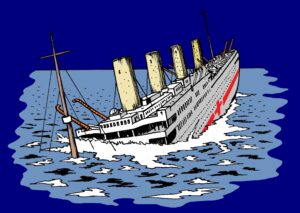Did you know that back in the age of steam, at the beginning of the twentieth century, the RMS Titanic and its two sister ships, the RMS Olympic and RMS Britannic were the biggest ships at sea?
The RMS Titanic
It was known to the world as “The Ship of Dreams”. It, as every child should know, sank dramatically on her maiden voyage on the night of April 14th, 1912.
The R.M.S (Royal Mail Ship) Titanic was built at the Harland and Wolff shipyards in Belfast for the White Star Line. In fact, they have built a museum there to The Titanic. If you ever go to Belfast, you should visit it
What many people don’t know is that it was one of three roughly identical ships built for the White Star Line and they were called Olympic class liners. The other two were:
The Olympic
Built before The Titanic and it lasted for 24 years from 1911 to 1935. These years included the first world war, when it was used as a troopship. The troops gave it the nickname Old Reliable, and the good news is it survived.
After the war she returned to being an ocean liner. She continued plying the seas until 1935, by which time both increased competition and the great depression made her unprofitable.
When she was built, she was the largest ocean liner in the world until The Titanic was built, as it had a slightly bigger gross tonnage. After The Titanic tragedy, for a short period, until the German ship SS Imperator came into service, it was the biggest.
However, she remained the largest British-built operating liner until RMS Queen Mary was launched in 1934.
 The Gigantic/ The Britannic
The Gigantic/ The Britannic
This one was planned as the third in the series. However, as a result of The Titanic disaster they decided that the name should be changed, so they renamed it The Britannic.
They also looked at the reasons she sank and spent some time adding a series of modifications that they hoped would make her safer and reduce the chances of her suffering the same fate.
Unfortunately, it was not ready until the start of World War 1, which meant that it was requisitioned as an hospital ship. In 1916 she saw service in the Dardanelles. Then, on 21 November 1916, she hit a mine near the Greek island of Kea and sank in 55 minutes!
Marine Technology
When they built The Titanic, it was believed that it was at the forefront of maritime technology. So, they thought! She had bulkheads running along her length that included watertight doors, these could be operated electrically from her bridge. It was also one of the first ships to go to sea with one of the first Marconi wireless sets.
Unfortunately, neither of these saved her when she hit the iceberg in the North Atlantic, so they added modifications to the other two ships. The Olympic led a charmed life. Unfortunately, The Britannic didn’t have time to use the modifications. Nothing can protect a ship from a devastating mine, that’s why they use them.
At the end of the day, the story of the RMS Titanic is a tragic one. However it is a story of those Edwardian days when great British luxury liners ruled the waves.

We believe that to make history fun, so children enjoy learning their history, they have to live these times. Therefore, so they understand the tragedy of The Titanic, our sister site Educational Musicals have published a schools musical The Ship of Dreams – The Voyage of the RMS Titanic.
It tells of the buildup and the tragedy through song and dialogue. To make it easier to perform, no speech is longer than five lines, along with twelve original songs so your children will love performing the show.
To hear two of the songs and read two pages of script please go to The Ship of Dreams – The Voyage of the RMS Titanic
Enjoy the show, as history matters.
10 questions to discuss:
- Beyond their size, what other features distinguished the Olympic-class liners from their contemporaries?
- How did the construction and design of these ships reflect the prevailing technological advancements and societal priorities of the early 20th century?
- What were the intended routes and passenger services offered by the Olympic-class liners, and how did they cater to different classes of travelers?
- How did the sinking of the Titanic impact the design and safety features of the Britannic, and what modifications were implemented?
- What challenges did the Olympic-class liners face during their operational careers, beyond the tragic fate of the Britannic?
- How did the First World War influence the roles and experiences of these ships, and what were the implications for their crew and passengers?
- Beyond the Titanic, what are some notable events or achievements associated with the RMS Olympic and its legacy?
- How do these ships continue to capture public imagination and inspire artistic interpretations, documentaries, and even fictional narratives?
- What broader historical and cultural lessons can we learn from the stories of the Olympic-class liners, considering their grandeur, achievements, and tragic aspects?
- If these ships were built today, how might they be different in terms of design, technology, and their place within the maritime industry?
These questions encourage further exploration and critical thinking by:
- Delving deeper into the ships’ design, features, and historical context.
- Examining the impact of historical events like WWI on the ships’ roles and fates.
- Analyzing the lasting cultural significance and lessons learned from these iconic vessels.
- Imagining their potential reimagining in a modern context.
For more on these ships:
https://www.titanicbelfast.com/explore/
https://www.mentalfloss.com/posts/titanic-sister-ships-olympic-britannic
https://study.com/academy/lesson/titanic-sister-ships-construction-uses-wrecks.html
© Tony Dalton


 The Gigantic/ The Britannic
The Gigantic/ The Britannic